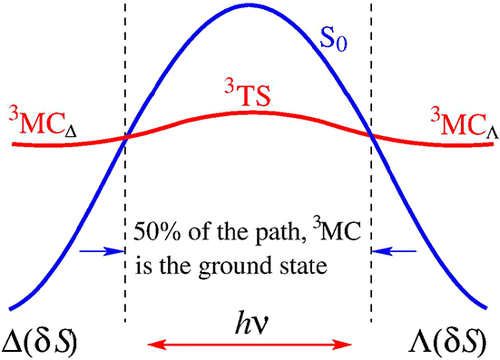当前位置:
X-MOL 学术
›
Inorg. Chem.
›
论文详情
Our official English website, www.x-mol.net, welcomes your feedback! (Note: you will need to create a separate account there.)
Triplet Ground-State-Bridged Photochemical Process: Understanding the Photoinduced Chiral Inversion at the Metal Center of [Ru(phen)2(l-ser)]+ and Its Bipy Analogues
Inorganic Chemistry ( IF 4.6 ) Pub Date : 2017-11-13 00:00:00 , DOI: 10.1021/acs.inorgchem.7b02030 Lixia Feng 1, 2 , Yuekui Wang 1 , Jie Jia 1
Inorganic Chemistry ( IF 4.6 ) Pub Date : 2017-11-13 00:00:00 , DOI: 10.1021/acs.inorgchem.7b02030 Lixia Feng 1, 2 , Yuekui Wang 1 , Jie Jia 1
Affiliation

|
One of the main concerns in the photochemistry and photophysics of ruthenium complexes is the de-excitation of the triplet metal centered ligand-field state 3MC. To understand the mechanism by which the 3MC states in some reversible photochemical reactions could avoid the fate of fast decay and ligand dissociations, the photoinduced chiral inversion at the metal center of the complexes [Ru(diimine)2(l-ser)]+ (diimine = 1,10-phenanthroline or 2,2′-bipyridine, l-ser = l-serine) has been analyzed at the first principle level of theory. The calculated equilibrium constants and ECD curves for the photoinduced equilibrium mixtures are in agreement with the observed ones. The results showed that the reversible photochemical process Δ(δS) ⇌ Λ(δS) on the potential surface of the lowest triplet excited state proceeds in three steps: 3CTΔ ↔ 3MCΔ, 3MCΔ ↔ 3MCΛ, 3MCΛ ↔ 3CTΛ, where the first and the third steps involve mainly the elongation and compression of the octahedral core of the reactant Δ(δS) and product Λ(δS), respectively. The chiral inversion Δ ↔ Λ takes place in the second step through a much distorted square-pyramid-like transition state, and actually proceeds on the triplet ground state 3MC due to the crossover of the triplet T1 and singlet S0 states. Inspecting the transient structures at the crossing points, we found that they become less distorted and their lowest or imaginary-frequency displacement vectors in triplet state still dominate the reaction path, which makes the reaction reversible without ligand release. Thus, the triplet ground-state-bridged photoinduced mechanism offers a new angle of view to understand the related reversible photochemical reactions.
中文翻译:

三重态基态桥联的光化学过程:了解[Ru(phen)2(l-ser)] +及其Bipy类似物的金属中心的光致手性反转。
钌配合物的光化学和光物理中主要关注的问题之一是对三重态金属居中的配体场态3 MC的激发。为了理解通过该机构3种在一些可逆光化学反应MC状态可避免快速衰减和配体解离的命运,光致手性转化在复合物的金属中心的[Ru(二亚胺)2(升-Ser)] +(二亚胺= 1,10-菲咯啉或2,2'-联吡啶,l -ser = l-丝氨酸)已在理论的第一原理水平上进行了分析。计算出的光致平衡混合物的平衡常数和ECD曲线与观察到的一致。显示的结果表明可逆光化学过程Δ(δ小号)⇌Λ(δ小号上的最低三重态激发态进行的在三个步骤中的电位表面):3 CT Δ ↔ 3 MC Δ,3 MC Δ ↔ 3 MC Λ,3 MC Λ ↔ 3 CT Λ,其中第一和第三步骤涉及主要是反应物Δ(δ的八面体核心的伸长和压缩小号)和产物Λ(δ小号分别地)。手性反转Δ↔Λ在第二步中通过一个非常扭曲的方金字塔形过渡态发生,并且由于三重态T 1和单重态S 0的交叉,实际上在三重态基态3 MC上进行。状态。检查交叉点处的瞬态结构,我们发现它们的畸变程度较小,并且它们在三重态下的最低或虚频位移矢量仍主导反应路径,这使反应可逆,而没有配体释放。因此,三重态基态桥联的光诱导机理为理解相关的可逆光化学反应提供了新的视角。
更新日期:2017-11-13
中文翻译:

三重态基态桥联的光化学过程:了解[Ru(phen)2(l-ser)] +及其Bipy类似物的金属中心的光致手性反转。
钌配合物的光化学和光物理中主要关注的问题之一是对三重态金属居中的配体场态3 MC的激发。为了理解通过该机构3种在一些可逆光化学反应MC状态可避免快速衰减和配体解离的命运,光致手性转化在复合物的金属中心的[Ru(二亚胺)2(升-Ser)] +(二亚胺= 1,10-菲咯啉或2,2'-联吡啶,l -ser = l-丝氨酸)已在理论的第一原理水平上进行了分析。计算出的光致平衡混合物的平衡常数和ECD曲线与观察到的一致。显示的结果表明可逆光化学过程Δ(δ小号)⇌Λ(δ小号上的最低三重态激发态进行的在三个步骤中的电位表面):3 CT Δ ↔ 3 MC Δ,3 MC Δ ↔ 3 MC Λ,3 MC Λ ↔ 3 CT Λ,其中第一和第三步骤涉及主要是反应物Δ(δ的八面体核心的伸长和压缩小号)和产物Λ(δ小号分别地)。手性反转Δ↔Λ在第二步中通过一个非常扭曲的方金字塔形过渡态发生,并且由于三重态T 1和单重态S 0的交叉,实际上在三重态基态3 MC上进行。状态。检查交叉点处的瞬态结构,我们发现它们的畸变程度较小,并且它们在三重态下的最低或虚频位移矢量仍主导反应路径,这使反应可逆,而没有配体释放。因此,三重态基态桥联的光诱导机理为理解相关的可逆光化学反应提供了新的视角。



























 京公网安备 11010802027423号
京公网安备 11010802027423号